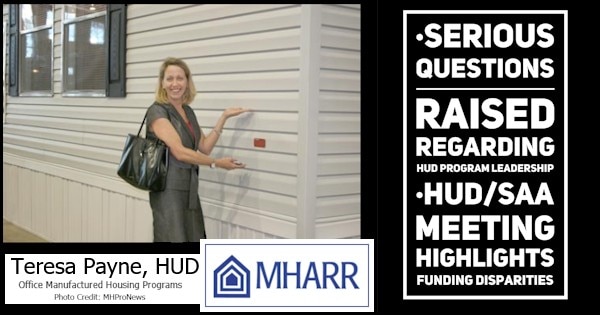
More Questions and Confusion Surround HUD Program Leadership
The HUD manufactured housing program conducted the latest in its ongoing series of regional State Administrative Agency (SAA) conferences on September 17-18, 2019 in Mobile, Alabama. The most significant development at the meeting was the surprise announcement (not by HUD, but by the host State Administrative Agency) that the “acting” HUD program Administrator since the 2017 termination of Pamela Danner – Ms. Teresa Payne – has now been designated as the program Administrator.
Aside from issues raised by a surprise announcement to a limited audience, this designation of a career HUD employee as program Administrator is directly contraryto section 620(a)(1)(C) of the Manufactured Housing Improvement Act of 2000 which, by its express and unambiguous terms, requires that the program Administrator be a “non-career” appointee. HUD’s action, moreover, appears to conflict with the recommendation just announced in the Department’s September 5, 2019 Housing Finance Reform Plan, that “HUD should elevate the Office of Manufactured Housing Programs within [the Department] and appoint a Deputy Assistant Secretary to lead it.” (Emphasis added). The Department’s action, therefore, and the curious manner of its announcement – again, not directly by HUD and/or the Administrator herself, but by the host SAA – will inevitably fuel new confusion and uncertainty regarding: (1) the future direction of the program itself; (2) the status and implementation of multiple regulatory reforms under Trump Administration Executive Orders 13771 and 13777 currently pending before the Manufactured Housing Consensus Committee (MHCC); and (3) the legitimacy of the program recommendations contained in the HUD Housing Finance Reform Plan issued under the name of Secretary Ben Carson.
Meanwhile, the failure to appoint a non-career administrator in accordance with the law is a clear indication of backsliding within the program and at HUD, directly contrary to the regulatory and governmental reform policies of President Trump and his Administration.
Indeed, this action, together with the selection, once again, of the 40-year-plus incumbent monitoring contractor to receive HUD’s latest DAPIA monitoring contract (and, presumably, the IPIA monitoring as well) as reported in the September 12, 2019 MHARR Washington Update, shows just how far the HUD program – despite Secretary Carson’s stated commitment to manufactured housing — has fallen. First, and most importantly, bothof these actions are contrary to, and in violation of, two of the most fundamental pillars of the 2000 reform law – i.e., the appointment of a non-career program administrator and the mandate for “separate and independent” contractors and a competitively-bid monitoring contract based on a statutorily-limited and defined “monitoring” function. Instead of these pillars being respected, implemented as stated, and even more importantly, institutionalized within the Department to ensure continuing compliance in the future, they continue to be ignored and violated. Second, the leak of the news of Administrator’s new status to a limited, select group, rather than by official HUD announcement to allstakeholders, with some type of explanation of HUD’s decision to continue its circumvention of the 2000 reform law’s requirements contrary to relevant Trump Administration policy, is indefensible and shows program stakeholders, who have been waiting nearly three years for program improvements under the present administration, that the status of the program is not improving and, arguably, is getting worse – a situation that is necessarily unacceptable.
It cannot be overstated that although regulatory abuses and overreach by the HUD program may have abated somewhat since the start of the Trump Administration, absent institutionalreforms to bring the program into full compliance with the 2000 reform law (e.g., an appointed non-career administrator, separate and independent program contractors, and an end to the 40-year monitoring contract de factomonopoly, among other things) such overreach – and worse – could easily snap back into place in the future, under a new and different administration.
HUD/SAA MEETING HIGHLIGHTS GROWING FUNDING DISPARITY
While the September 17-18, 2019 HUD/SAA meeting in Mobile, Alabama focused largely on education and inspection-related issues, one consistent theme underscored by multiple participants was the lack of adequate funding for state-level manufactured housing programs. Following Michigan’s recent withdrawal from participation in the HUD program, New Jersey has also withdrawn, and Pennsylvania will be exiting the installation regulation program as of October 1, 2020, at which time installation-related functions will default back to HUD. This action was attributed in substantial part to a lack of adequate funding, with program fees effectively frozen by state authorities and HUD payments to state SAAs essentially unchanged for years.
The withdrawal of these states from all or part of the HUD program reflects a much broader problem as HUD pays more and more to its entrenched contractor, while state funding has remained static (or has effectively diminished over the years due to the impact of inflation). In its latest Fiscal Year (FY) 2020 program budget proposal, for example, HUD budgets $8.4 million for contractor functions, up from $7.4 million in its prior-year proposal, at a time when industry production has experienced a near year-long decline. Meanwhile, SAA funding is budgeted for $3.6 million, with no change from FY 2018 and 2019, even as the number of homes SAAs are responsible for continues to increase.
This continuing disparity in funding between state SAAs which serve the people, policies, and interests of large numbers of Americans, and an entrenched contractor seeking to maximize its own earnings through ever more burdensome pseudo-regulation, is unacceptable and continues to be a significant focus of MHARR activity in Washington, D.C.
MHARR is a Washington D.C.-based national trade association representing the views and interests of independent producers of federally-regulated manufactured housing.
The “MHARR Washington Update” is available for re-publication in full or in part, (without alteration or substantive modification) without further permission and with proper attribution to MHARR.





